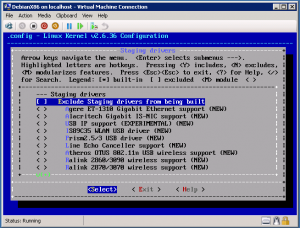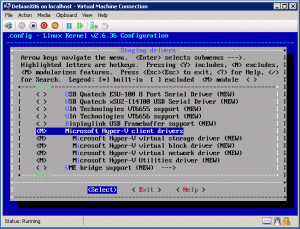
Categories

Sponsors


Archive
 Blogroll 
Badges


Community

|
Posted in Linux Server, Virtual Machine Manager | 13 Comments | 27,140 views | 07/01/2011 23:29
I created a new kernel image for Debian x86 (32 bit). If you have to use 32bit OS for your application needs, you can use this deb packages to upgrade your kernel. Also you will have integrated shutdown feature. 1) Install a clean Debian 5.0.6 2) Do following:
That’s it. Reboot your server with new kernel.
Posted in Linux Server, Virtual Machine Manager | 24 Comments | 45,770 views | 07/01/2011 16:51
If you have a kernel image for your Linux virtual machine, it’s easy to upgrade your kernel for Hyper-V support. 1) Install a clean Debian virtual machine (Use emulated Ethernet card and 1 vCpu) 2) Use commands below to update your virtual machine:
At menuconfig, go to: Device Drivers -> Stagging Drivers Now choose Microsoft Hyper-V Client Drivers After that you can enter to exit with saving changes. Use commands below to continue:
After this process, you will find your two .deb files in /usr/src directory. Possible problems: 1) You may get this error when you try to compile kernel.
Please check this page to fix this issue: 2) You may get this error when you try to compile kernel.
Please check this page to fix this issue: If you get different problems, please report to me.
Posted in Windows Server | No Comment | 4,770 views | 24/03/2009 01:20
As you know Hyper-V supports VSS so you don’t need to shutdown or save state virtual machine when you want to backup them. But If want to backup virtual machines with Windows Server Backup utility, we need to do small registry trick. You should do some registry changes to support Hyper-V on Windows Server Backup. I created small reg files to do that:
Save as HyperVBackup.reg then use this command to import:
You can find an article on Microsoft about backing up by Windows Server Backup (KB958662)
Posted in Virtual Machine Manager | No Comment | 6,512 views | 20/03/2009 20:32
You may get this error when you try to clone a vm. Solution: If you are using SCVMM, simply delete vm then re-clone it. Be sure, all vm files are deleted before cloning process. Error (12700)
VMM cannot complete the Hyper-V operation on the hyperv02.contoso.fabrikam.com server because of the error: Failed to import the virtual machine from import directory ‘E:\Hyper-V\W2K8WEB’. Error: One or more arguments are invalid(0x80070057) Import file format error: E:\Hyper-V\W2K8WEB\Virtual Machines\0D6B7434-D1B3-4BF7-A414-8E29FE56D496.exp. Recommended Action If you are doing this on Hyper-V, there is a good solution: http://social.technet.microsoft.com/Forums/en-US/winserverhyperv/thread/5b731f1a-f495-4d88-a875-0eea77ecd6b4
Posted in Virtual Machine Manager | No Comment | 6,655 views | 18/03/2009 20:21
You have a working template but you want to install new windows updates and re-template it. You installed updates then started to update step. But what is that? Sysprep hangs on %49. Then SCVMM gives this error: Error (680)
Timeout occurred while waiting for Sysprep to finish processing on the virtual machine. Recommended Action Unfortunately you can’t sysprep a Windows Server 2008 with SCVMM more than 3 times. Your licence does not accept sysprep after 3 syspreping. This is really bad but you don’t have any another way. You should create a new machine and then you should make it template. I don’t know what the exact number is, but Vista supports only 3 syspreping.
Posted in Virtual Machine Manager | No Comment | 2,377 views | 08/03/2009 01:38
SCVMM üzerinde Intel işlemcili sunucudan Amd işlemcili sunucuya live migrate yapamamaktasınız. Transfer işlemini gerçekleştirmek için Hyper-v üzerinden Export/Import işlemi gerçekleştirebilir ya da direk vhd dosyasını, Hyper-v üzerinden attach edebilirsiniz.
Posted in Virtual Machine Manager, Windows Powershell, Windows Server | No Comment | 3,804 views | 06/03/2009 12:13
SCVMM üzerinden yönettiğimiz tüm sanal sunucuların “Running”, “Saved” ya da “Stopped” gibi durumlarını, Powershell üzerinden html çıktısı olarak alabiliriz. Böyle bu Powershell scriptini, zamanlanmış görev olarak eklediğinizde, size belirli aralıklarla güncel durumları iletecek bir monitoring sayfası yapmış olacaksınız. Sonuç olarak sürekli birinin SCVMM üzerinden sunucu durumlarını izlemesi gerekmiyor.
Yukarda görebileceğiniz gibi tüm VM’leri VMHost sırasına göre sıraladık ve sadece Name, Status ve VMHost’u gösterecek şekilde html’e attık. Property’leri get-vm yaptığınızda karşınıza gelen çıktıdan alabilirsiniz. Fakat örneği her makinayı incelemek istemiyorsunuz. Belki de sürekli stopped kalacak makinalar var. Sadece belirli prefixlere sahip sunucuları monitoring etmek istediniz, o zaman ne yapacağız?
Son durumda sadece işimize yarar sunucuların gösterilmesini sağladık. Yukardaki senaryoda, çıktı olarak karşınıza sadece VM ile başlayan makinalar çıkacaktır. Bunu da -match ile sağlıyoruz. Dikkat ederseniz burada VMHost’a göre sıralamayı kaldırdık, isme göre sıralandırdık. Ayrıca sadece isim ve durumları bastırdık. Powershell üzerinden neredeyse hayal ettiğiniz her şeyi yapabilirsiniz. Bir sonraki yazıda yukardaki çıktıyı biraz renklendireceğiz ve bir nevi Argus yapmış olacağız. Yukardaki kodları sadece SCVMM için değil, Windows servisleri için de uyarlayabilirsiniz. O yüzden bu yazıyı Windows Server içersine de ekliyorum. Kolay gelsin. |












